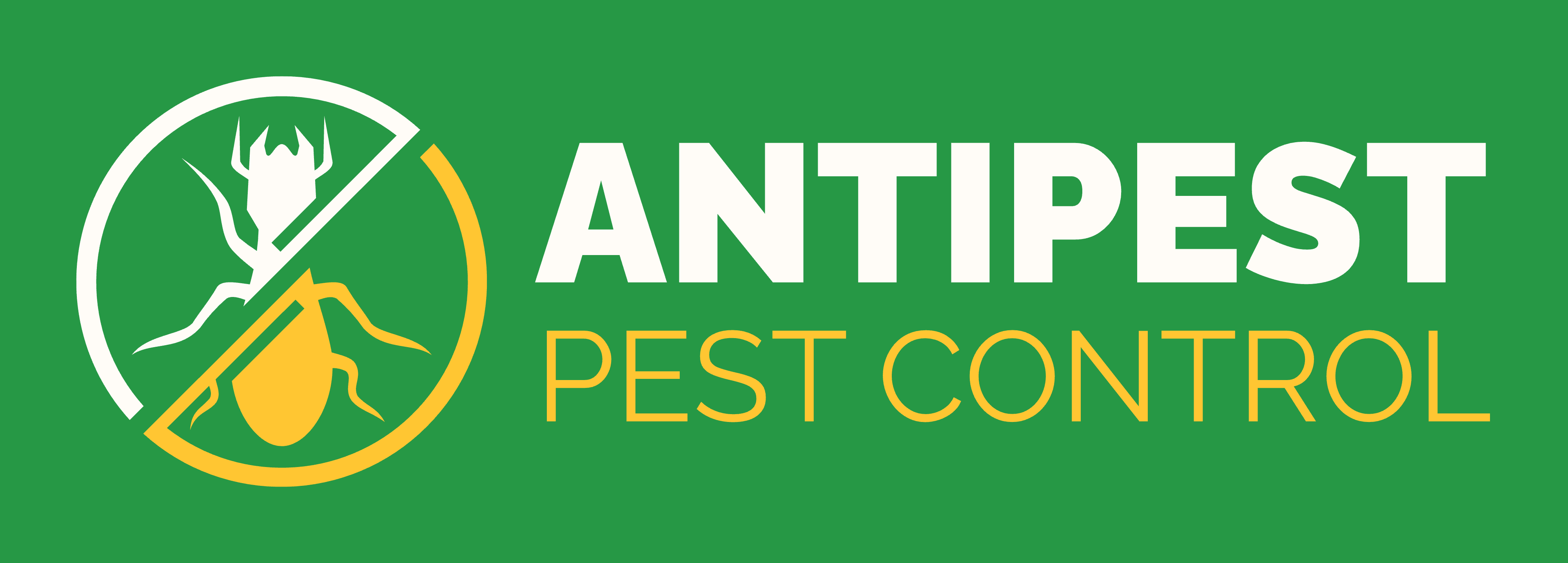Ants are among the most common insects found across the world, but not all ants are the same. One of the most frequent debates revolves around red ants vs black ants, as these two types are encountered almost daily in homes, gardens, and agricultural areas. While both belong to the ant family Formicidae, their behavior, habitat, diet, and interaction with humans differ significantly. If you have ever wondered which type of ants are invading your kitchen, biting your feet outdoors, or damaging plants, understanding the distinction between red ants vs black ants is crucial.
Recognizing their unique characteristics also helps in identifying infestations quickly. Moreover, knowing the behavioral differences of red ants vs black ants can guide you in applying the right control strategy for each situation. In this article, we’ll break down their biology, compare habitats, analyze behavior, and offer prevention tips, giving you full clarity on red ants vs black ants once and for all.
Table of Contents
Understanding Red Ants vs Black Ants
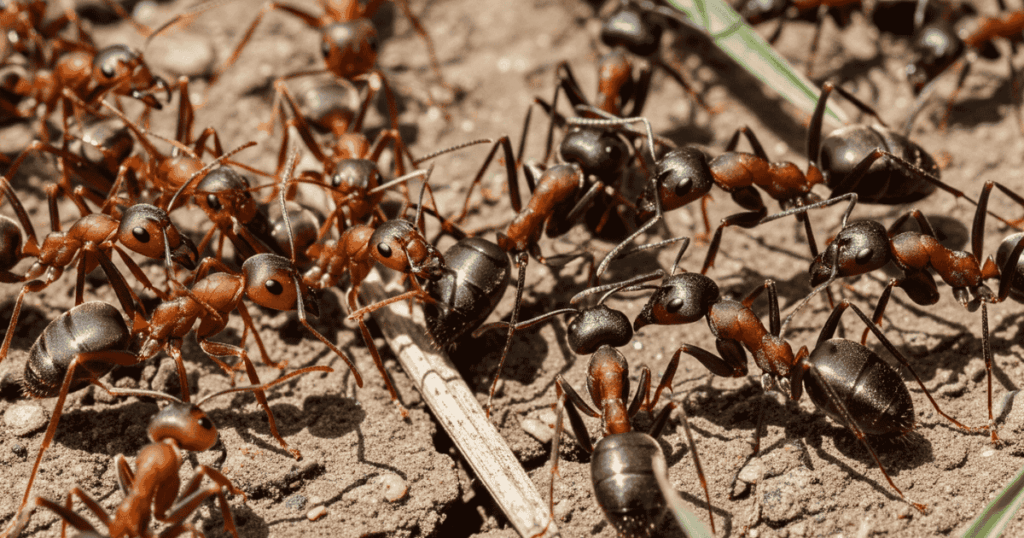
When discussing red ants vs black ants, it’s important to first recognize that color isn’t the only differentiating factor. These ant varieties also differ in aggressiveness, food preference, and ecological importance. Red ants, for instance, are often more aggressive and capable of delivering painful bites or stings, while black ants may be more harmless but can cause inconvenience inside homes when building colonies.
This distinction provides insights into why one infestation may be harder to control than another. Let’s uncover their defining characteristics before going deeper into comparisons.
Physical Appearance: Red Ants vs Black Ants
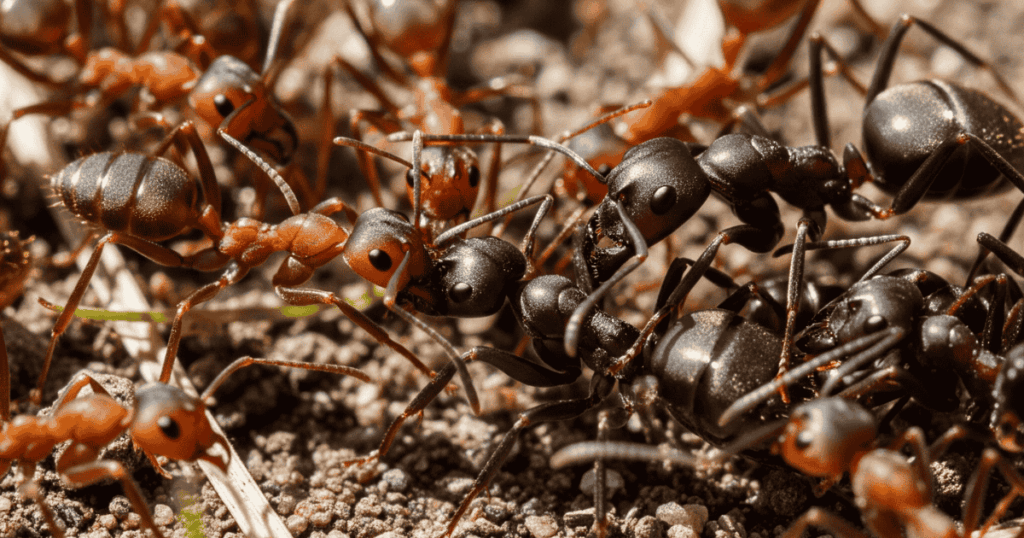
The first obvious difference between red ants vs black ants is their color, but several other physical distinctions also exist. While both species share segmented bodies, they have subtle variations in their build.
Size and Appearance
- Red ants tend to be smaller, usually between 1/8 to 1/4 inch long
- Black ants have a wider size range; some carpenter ants are large (up to 2 inches), while others are tiny (around 1.5 mm)
Body Features
- Red ants usually have a stinger, used for defense and hunting
- Black ants lack a stinger but often use formic acid sprayed from their abdomen as a defense mechanism
| Feature | Red Ants | Black Ants |
| Color | Reddish-brown to vibrant red | Jet black or dark brown |
| Size | Usually smaller, 2–6 mm | Larger in general, 3–7 mm |
| Sting/Bite | Painful sting (fire ants are notorious) | Less painful bite, often harmless |
| Temperament | Aggressive | Passive or mildly aggressive |
This table highlights why people often express more concern when dealing with red ants than with black ants.
Habitat: Where Do Red Ants vs Black Ants Live?
The preferred living places of ants also help distinguish the two. By examining red ants vs black ants habitats, you’ll notice sharp contrasts in their adaptability.
Red Ants:
- Thrive in sandy soil, dry lawns, and open outdoor spaces.
- Build visible mounds, sometimes several feet wide.
- Colonies are highly structured and aggressive toward intruders.
Black Ants:
- Prefer moist environments and decaying wood.
- Frequently found inside homes searching for sugary substances.
- Colonies often remain hidden and are less disruptive to soil.
| Habitat Factor | Red Ants | Black Ants |
| Preferred Environment | Dry, hot outdoor zones | Damp, indoor-friendly |
| Nest Visibility | Large sand mounds | Often hidden in cracks, wood |
| Household Presence | Rare indoors | Common indoors |
This comparison clears up why red ants are often associated with gardens and lawns, while black ants dominate kitchens and pantries.
Behavior and Aggression: Which Ants Are More Dangerous?
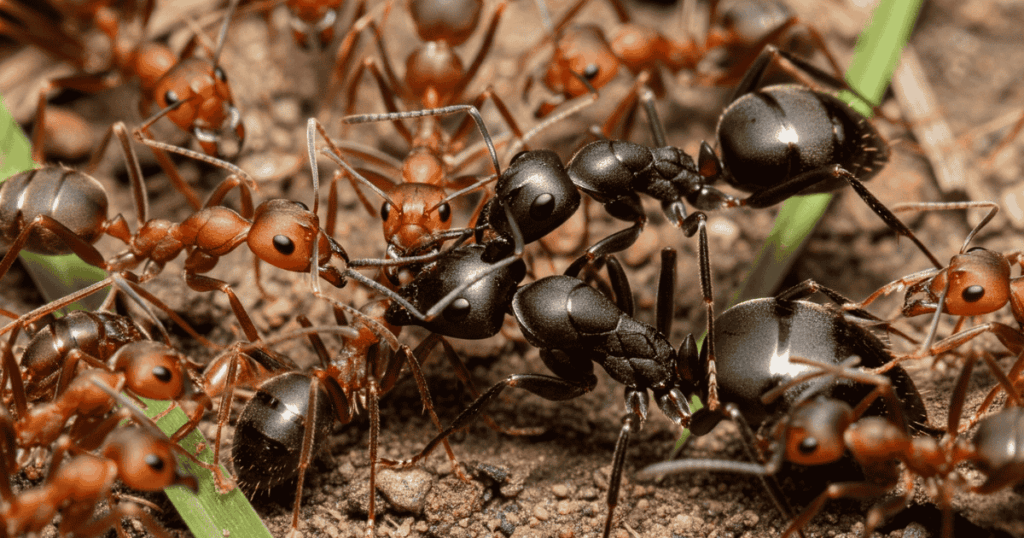
When comparing red ants vs black ants, one of the biggest differences lies in their behavior toward humans.
- Red Ants: Known for their aggressiveness, red ants can attack in swarms when nests are disturbed. Fire ants, a type of red ant, deliver venomous stings that can cause severe itching, swelling, and allergic reactions in some people.
- Black Ants: Typically non-aggressive, black ants may enter homes in search of food but rarely attack. Their bites, if any, are mild and don’t usually require medical attention.
This key variance informs strategies for dealing with infestations since red ants require more urgent countermeasures due to their painful sting.
Diet and Feeding Habits of Red vs Black Ants
Red ants vs black ants differ in their dietary preferences. Understanding what they feed on can help in managing their infestations.
- Red Ants: Mostly predators and scavengers. They consume other insects, plant seeds, and sometimes protein-rich food sources. They are highly opportunistic.
- Black Ants: Strong preference for sweet substances. They frequently raid pantries for sugar, honey, or bread crumbs. They also farm aphids for honeydew.
| Aspect | Red Ants | Black Ants |
| Preferred Diet | Protein, insects, seeds | Sugary foods, honeydew |
| Home Attractants | Meat scraps, greasy items | Sugar, syrups, sweets |
| Farming Behavior | Rare | Common (with aphids) |
Effective Pest Control: Managing Red Ants vs Black Ants
Both red and black ants require different management strategies. Knowing their behavior and habitats helps choose appropriate control methods.
Controlling Red Ants
- Identify and disrupt nests using targeted insecticides or natural methods like boiling water or diatomaceous earth
- Wear protective gear when handling infestations due to painful stings
- Maintain yard cleanliness and reduce soil disturbances around homes
Managing Black Ants
- Locate nests indoors, especially in damp wooden areas, and use baits or sprays directed at the colony
- Fix leaks and reduce moisture to discourage nesting
- Seal cracks and food sources to prevent indoor infestations
Role in the Ecosystem: Benefits of Red Ants vs Black Ants
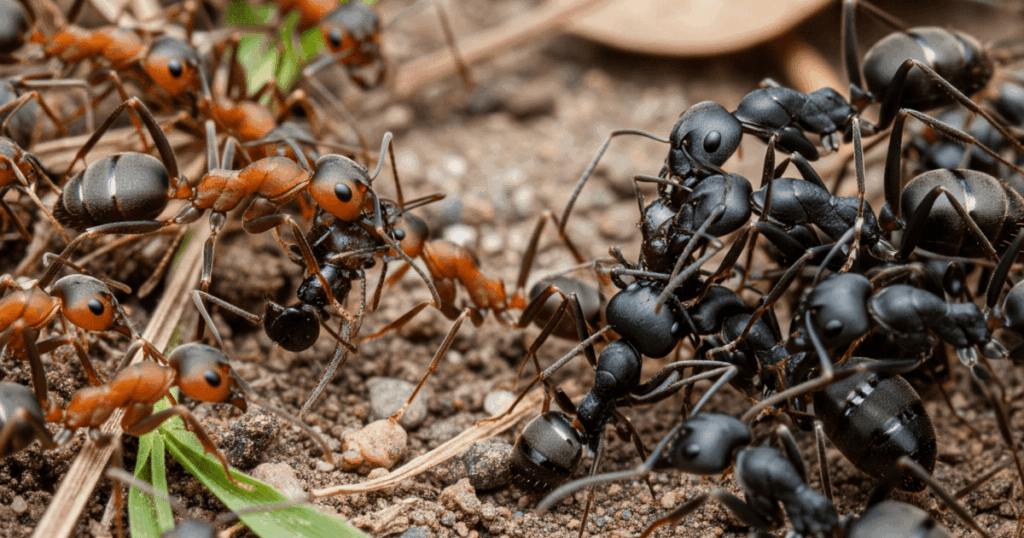
Though considered pests, both varieties serve ecological functions. The “red ants vs black ants” discussion isn’t always negative; both insects contribute essential roles in nature.
Red Ants:
- Aid in pest control by preying on other insects.
- Aerate soil through mound building.
- Act as scavengers, cleaning up biological waste.
Black Ants:
- Help recycle organic material.
- Disperse seeds through their movements.
- Serve as a food source for birds, reptiles, and amphibians.
Thus, while infestations annoy people, removing ants entirely would disrupt natural ecosystems.
Damage Potential and Risks: Red Ants vs Black Ants
Understanding the level of threat posed by red ants vs black ants can guide how to protect property and health.
- Red ants (fire ants) can cause painful stings, allergic reactions, and aggressive attacks. Though they rarely cause structural damage, their presence is a considerable health risk outdoors.
- Black ants are mostly a nuisance but can cause serious damage in the case of carpenter ants, which hollow out wood to nest, potentially weakening structures over time. Other black ants mainly contaminate food and create annoyance.
| Risk Type | Red Ants | Black Ants |
| Health Threat | Painful stings, allergic reactions | Rarely harmful |
| Structural Damage | Minimal | Carpenter ants can damage wood |
| Infestation Signs | Large mounds, aggressive swarming | Trails indoors, wood damage |
“Know how to get rid of little black ants and protect your family from unwanted pests.”
Red Ant Bites vs Black Ant Bites: Which Hurts More?
When evaluating red ants vs black ants, bites and stings are perhaps what most people care about.
- Red Ant Bite/Sting: Causes sharp pain, itching, swelling, and redness. Some individuals develop allergic reactions. Fire ant stings are especially notorious for leaving blister-like marks.
- Black Ant Bite: Often painless or minor. At worst, they cause mild irritation that fades quickly.
| Bite/ Sting Factor | Red Ants | Black Ants |
| Pain Level | High | Low |
| Allergy Risk | Moderate to high | Rare |
| Visible Reaction | Swelling, blisters | Light redness |
This comparison underscores why red ant infestations raise more concern.
How to Control Red Ants vs Black Ants?
Eliminating ants depends on their species. Approaches to handling red ants vs black ants differ due to their unique behaviors.
Controlling Red Ants
- Apply ant-specific insecticides directly to mounds.
- Avoid disturbing nests without protection.
- Use baited traps containing protein-rich lures.
Controlling Black Ants
- Eliminate all food crumbs and sealed sugary items.
- Spray natural repellents like vinegar solution.
- Close entry points in walls, cracks, or cupboards.
| Control Strategy | Effective for Red Ants | Effective for Black Ants |
| Insecticide Bait | Yes | Yes |
| Vinegar Spray | Limited | Very effective |
| Sealing Cracks | Somewhat | Highly effective |
Cultural Beliefs About Red Ants vs Black Ants
Across cultures, ants symbolize teamwork, patience, and resilience. Interestingly, red ants vs black ants signify different beliefs in superstitions:
- Red Ants: Often thought to bring misfortune or aggressive energy if seen indoors.
- Black Ants: Sometimes believed to signal prosperity and abundance, especially when entering kitchens.
Though these beliefs are not scientifically proven, they influence human perception of ants.
When to Call a Professional for Red Ants vs Black Ants?
Knowing when to call a professional pest control service is crucial for effectively handling red ants vs black ants infestations. While small ant sightings might be managed with DIY methods, some signs clearly indicate the need for expert help.
- Persistent Ant Presence: Ants keep returning despite your efforts, signaling a large or hidden colony requiring professional treatment.
- Large Infestations: Multiple trails or nests around your property mean the infestation is extensive and needs comprehensive control.
- Structural Damage: Carpenter ants (a black ant type) cause wood damage, necessitating expert intervention to prevent costly repairs.
- Health Risks: Red ants are aggressive and sting painfully. Professionals ensure safe removal to protect family and pets.
- Failed DIY Attempts: When store-bought or home remedies fail, professional treatments target the entire colony for lasting results.
Calling a professional ensures thorough, safe, and effective management of your red ants vs black ants problem.
For comprehensive and hassle-free Red Ants vs Black Ants removal and long-term pest prevention, trust the professionals at Antipest Office. Visit us at the Antipest Office, Our trained technicians use safe and effective methods to protect your home and business. For service bookings and consultations, call us at +91 9819018398 .
Conclusion: Final Thoughts on Red Ants vs Black Ants
The comparison of red ants vs black ants shows that while they belong to the same family, their traits are remarkably different. Red ants are aggressive, outdoor-dominant, and capable of stings that can cause discomfort or harm. Black ants are relatively harmless, frequent homes often, and prefer sugary diets.
Understanding red ants vs black ants is essential for appropriate control methods, ensuring a safe household, and appreciating their ecological value. Next time you encounter ants, identify whether they’re red or black, it could save you from unnecessary bites or ineffective control strategies.
Red Ants vs Black Ants – FAQs
What is the key difference between red ants vs black ants?
Red ants are aggressive with painful stings, while black ants are mostly harmless and prefer sweeter foods, making them common in homes.
Which are more aggressive in red ants vs black ants?
Red ants are far more aggressive, stinging in swarms when disturbed. Black ants are passive and usually harmless around people.
How do red ants vs black ants differ in habitat?
Red ants thrive outdoors in sandy areas, while black ants often build hidden nests indoors in damp or food-rich environments.
Which bites hurt more in red ants vs black ants?
Red ant bites are painful and venomous, often causing swelling. Black ant bites are minor and rarely require medical attention.
What do red ants vs black ants eat?
Red ants consume proteins, seeds, and insects, while black ants mostly prefer sugar, honeydew, and other sweet human food sources.
How do red ants vs black ants impact households?
Red ants attack aggressively outdoors, posing risk with stings. Black ants infest kitchens, spoiling food but rarely cause direct harm.
Are red ants vs black ants equally beneficial in ecosystems?
Both types benefit ecosystems differently, red ants aerate soil and prey on pests, while black ants disperse seeds and recycle organic waste.
Which infest homes more frequently: red ants vs black ants?
Black ants infest homes more often due to their preference for sugar and damp spaces. Red ants usually remain outdoors in mounds.
How do red ants vs black ants react to humans?
Red ants attack aggressively when threatened, while black ants usually avoid confrontation, remaining non-aggressive unless provoked.
Which are harder to control: red ants vs black ants?
Red ants are harder to control due to aggressive colonies. Black ants are persistent but manageable with cleanliness and sealing food sources.

